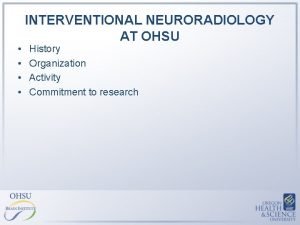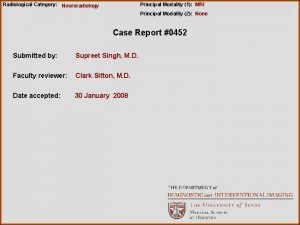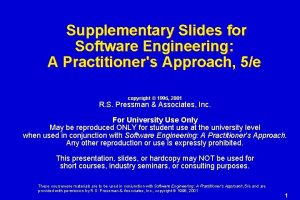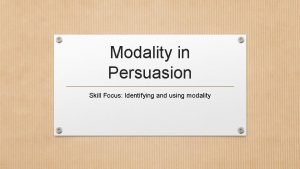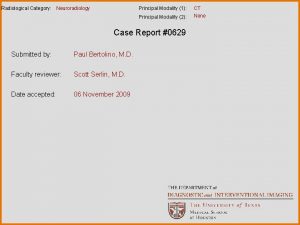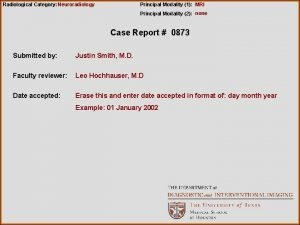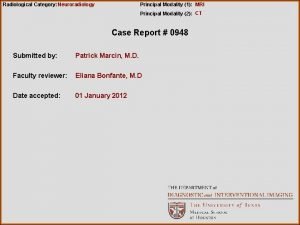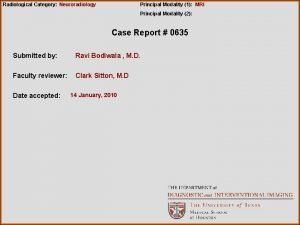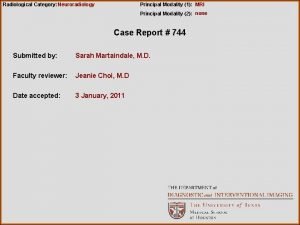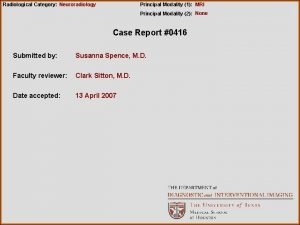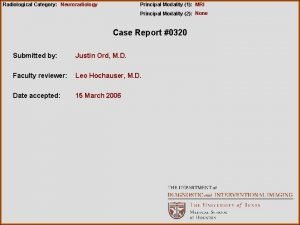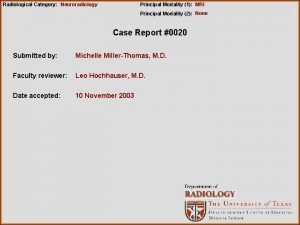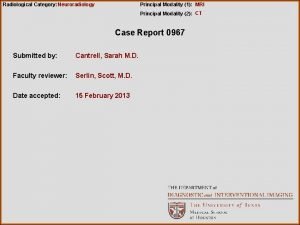Radiological Category Neuroradiology Principal Modality 1 MRI Principal












- Slides: 12

Radiological Category: Neuroradiology Principal Modality (1): MRI Principal Modality (2): None Case Report #0159 Submitted by: Neil Bhargava, M. D. Faculty reviewer: Leo Hochhauser, M. D Date accepted: 01 January 2005

Case History 35 year old with a pulsatile, painless angle of mandible mass.

Radiological Presentations

Radiological Presentations

Radiological Presentations

Test Your Diagnosis Which one of the following is your choice for the appropriate diagnosis? After your selection, go to next page. • Carotid bulb ectasia • Jugulodigastric node hyperplasia • Vagal schwannoma • Vagal neurofibroma • Glomus vagale paraganglioma • Carotid body paraganglioma

Findings and Differentials Findings: Axial T 1 WI MR demonstrates an avidly enhancing mass splaying the right internal and external carotid arteries at the carotid bifurcation. Flow voids within the mass, as represented by punctate areas of low T 1 and T 2 signal, are best seen on the sagital T 2 WI. Note the normal flow voids in the carotid artery. Differentials: • Carotid bulb ectatasia • Jugulodigastric node hyperplasia • Vagal schwannoma • Vagal neurofibroma • Glomus vagale paraganglioma • Carotid body paraganglioma

Discussion The carotid space is a tubular space enveloped by the carotid sheath containing the carotid arteries, internal jugular veins, and cranial nerves 9 -12, and extends from the skull base to the aortic arch. A mass is within the carotid space if the center is within the area of the ICA and IJV posterior to the parapharyngeal space. It will displace the posterior belly of the digastric muscle laterally and the parapharyngeal fat anteriorly. When a mass in the carotid space is found, the differential follows the anatomy (1): • ICA lesions: ICA tortuosity, dissection, pseudoaneurysm, thrombosis. • IJV lesions: thombophlebitis, thrombosis • Glomus bodies: carotid body paraganglioma, glomus vagale paraganglioma • CN 9 -12: schwannoma or neurofibroma

Discussion Carotid bulb ectasia occurs in older patients with atherosclerosis. On imaging, an enlarged, ectatic, calcified carotid bulb is seen. Jugulodigastric node hyperplasia occurs in patients who are generally asymptomatic and an enlarged, non-necrotic node pulsates against the carotid bulb, rather than with it. Vagal schwannoma can occur sporadically or in association with NF 2. On imaging, a fusiform enhancing mass does not splay the ECA-ICA and may show intramural cysts. Vagal neurofibroma can occur sporadically or in association with NF 1. CECT shows a low-density, well-circumscribed mass that does not splay the ECA-ICA. MR imaging cannot reliably differentiate from vagal schwannoma. Glomus vagale paraganglioma presents with vagal neuropathy and a posterolateral high oropharyngeal mass. The mass is centered approximately 2 cm below the skull base and shows high-velocity flow voids on T 1.

Discussion Carotid body paragangliomas are benign vascular tumors arising in the glomus bodies in the crotch of the ECA and ICA at the bifurcation. The mass splays ECA and ICA, is avidly enhancing and occasionally has a “salt & pepper” appearance on T 1 WI. The “salt” appearance is a rare finding occurring secondary to subacute hemorrhage. The “pepper” appearance is related to punctate or serpentine flow voids due to the high vascularity in the fibrous matrix of the carotid body paraganglioma. ON T 2 WI, the signal is slightly above that of muscle. T 1 C+ demonstrates intense enhancement. Ultrasound shows a solid inhomogeneous, vascular mass at the carotid artery. Prolonged, intense tumor blush with “early vein” shunting is noted on angiography. The main feeding branch is the ascending pharyngeal artery. Angiography provides a vascular road map for the surgeon, searches for multicentric tumors, and evaluates collateral arterial and venous circulation of the brain (important if sacrifice of a major vessel becomes necessary). Surgical cure without lasting post-operative cranial neuropathy is expected in tumors less than 5 cm. Larger tumors may have post-operative permanent vagal and hypoglossal neuropathy. Malignant transformation is extremely rare (2, 3). KEYS TO DIAGNOSIS: parenchymal “pepper” (high velocity flow voids) + splayed ECA-ICA is diagnostic for a carotid body paraganglioma.

Discussion References: - HR Harsberger et al. Diagnostic Imaging: Head and neck. Carotid space. Amirsys 2004, pp III 8 -2 to III 8 -3. - HR Harsberger et al. Diagnostic Imaging: Head and neck. Carotid body paraganglioma. Amirsys 2004, III 8 -20 to III 8 -23. - AB Rao, KK Koeller, CF Adair. Paragangliomas of the head and neck: radiologic -pathologic correlation. Radiographics 1999 (19), 1605 -1632.

Diagnosis Carotid body paraganglioma.
 Ohsu neuroradiology
Ohsu neuroradiology Erate pa
Erate pa Center for devices and radiological health
Center for devices and radiological health National radiological emergency preparedness conference
National radiological emergency preparedness conference Radiological dispersal device
Radiological dispersal device Tennessee division of radiological health
Tennessee division of radiological health Mri principal
Mri principal Modality in software engineering
Modality in software engineering Deontic and epistemic modality exercises
Deontic and epistemic modality exercises Modality in software engineering
Modality in software engineering Data modeling fundamentals
Data modeling fundamentals Lexical vs auxiliary verbs
Lexical vs auxiliary verbs High modality examples
High modality examples
